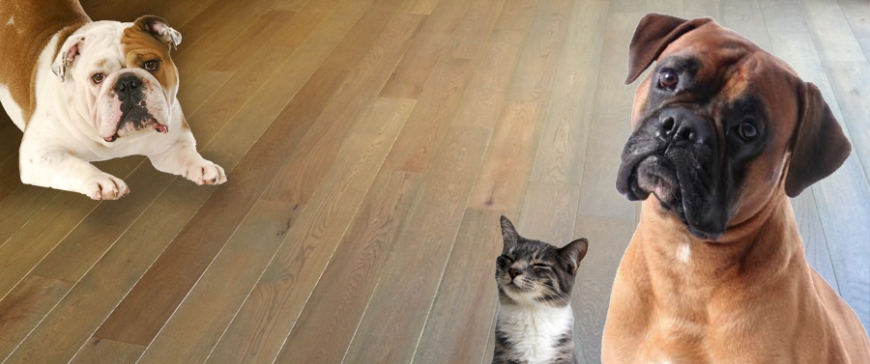The first thing you should know is that No real hardwood floor is invincible. There are certain specifications you may want to keep in mind when it comes to choosing a hardwood floor for your pet friendly home.
So the question is – Can you have pets and hardwood floors?
The response is YES YOU CAN install hardwood floors and still enjoy all the benefits of it without having the stress of them destroying it.
Our recommendation will be:
- The proper training of your dog and the used of training pads with absorbent surfaces and plastics, preventing any liquid to touch your floor – but if it does just remember to clean it right away.
- To prevent scratches on your hardwood floors, make sure to make it routine to clip and trim your pets nails.
- To feed your pets, use heavy bowls to make it more stable so you can prevent spilling as well as using waterproof mats under the bowls.
- Choose pre-finished hardwood flooring – it is a harder and can have more durable finish. Most of the major manufacturers of hardwood flooring these days use an Aluminum Oxide finish. This includes minuscule flecks of aluminum inserted into a layer of the finish, creating a stronger surface coating. Additionally, manufacturers are able to cure prefinished hardwood planks under UV lights, hardening the coats of finish even more.
- Lighter wood species or stained products have a tendency to camouflage scratches and dents, so they are a lot less noticeable than they would be on a darker wood species or a dark stained hardwood floor.
- Surface texture can also help to hide scratches or dents caused by pets in your home. Handscraped flooring is becoming popular in homes across the nation for the warmth and character it adds to a room, but since the surface is already textured, appearance of scratches and dents become minimized as compared to those on a smooth surface hardwood floor.
- Choose very hard wood species like Brazilian walnut, natural maple, hickory or amendoim between others.
Here is a list of strong hardwood floors based on the Janka Hardness rating Chart.
The Janka hardness test measures the resistance of a sample of wood to denting and wear. It measures the force required to embed an 11.28mm (.444 in) steel ball into wood to half the ball’s diameter. This method leaves an indentation. A common use of Janka hardness ratings is to determine whether a species is suitable for use as flooring. WIKIPEDIA
RATING BASED ON JANKA HARDNESS RATING CHART
| WOOD FLOORING SPECIES | POUNDS FORCE |
|---|---|
| Piptadenia Macrocarpa, Curupay, Angico Preto, Brazilian Tiger Mahogany | 3840 |
| Brazilian Olivewood | 3700 |
| Brazilian Ebony | 3692 |
| Brazilian Walnut , Lapacho | 3684 |
| Sucupira, Brazilian Chestnut, Tiete Chestnut | 3417 |
| Massaranduba, Brazilian Redwood, Paraju | 3190 |
| Red Mahogany, Turpentine | 2697 |
| Southern Chestnut | 2670 |
| Brazilian Cherry, Jatoba | 2350 |
| Mesquite | 2345 |
| Santos Mahogany, Bocote, Cabreuva, Honduran Rosewood | 2200 |
| Brazilian Koa | 2160 |
| Osage Orange[4] | 2040 |
| Goncalo Alves, Tigerwood | 1850 |
| Hickory, Pecan, Satinwood | 1820 |
| Rosewood | 1780 |
| Blackwood | 1720 |
| Wenge, Red Pine, Hornbeam | 1630 |
| True Pine, Timborana | 1570 |
| Sweet Birch | 1470 |
| Hard Maple, Sugar Maple | 1450 |


